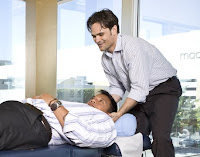 Walking around in pain? Disabled? You’re not alone: Twenty percent of Americans have a disability, according to new reports out of the Centers of Disease Control (CDC). The CDC reports that the number of people with disabilities rose 7.7% over a six year period. From 1999-2005, the number of disabled Americans has reached 48 million. Pretty pathetic considering most of the top disabilities have a sound solution. Let’s take a look:
Walking around in pain? Disabled? You’re not alone: Twenty percent of Americans have a disability, according to new reports out of the Centers of Disease Control (CDC). The CDC reports that the number of people with disabilities rose 7.7% over a six year period. From 1999-2005, the number of disabled Americans has reached 48 million. Pretty pathetic considering most of the top disabilities have a sound solution. Let’s take a look:
- Arthritis was the leading cause of disability, affecting 8.6 million people
- Back and spine problems were next at 7.6 million people
- Heart related disabilities knocked down 3 million people
- Women were more disabled than men
- And the CDC predicts that the overall numbers will continue to rise as baby boomers age
What makes this scenario sad is that most of the disabilities hobbling our countrymen are treatable or preventable. Arthritis, low back pain, neck pain and other musculoskeletal pain conditions are all effectively treated by chiropractic care. But are doctors recommending it to their patients? Seeing that less than twenty percent of the population is taking advantage of chiropractic care, it’s not surprising that the numbers of disabled are so high.
 Fortunately, the younger generations are turning to chiropractic to prevent future disabilities. I see it in my own practice. Baby boomers come, but not as much as Gen Xers and Millennials. I guess what grandma and grandpa tended to pass on, kids are embracing. Very smart youngsters, very smart. You don’t have to take on the family legacy and fulfill the CDC’s prediction of “more disabled” by 2030. On the contrary, if instead we do what the CDC recommends to stop the trend–that is, focus on “disability prevention” through safe, effective chiropractic care, then I’m certain these numbers will come down.
Fortunately, the younger generations are turning to chiropractic to prevent future disabilities. I see it in my own practice. Baby boomers come, but not as much as Gen Xers and Millennials. I guess what grandma and grandpa tended to pass on, kids are embracing. Very smart youngsters, very smart. You don’t have to take on the family legacy and fulfill the CDC’s prediction of “more disabled” by 2030. On the contrary, if instead we do what the CDC recommends to stop the trend–that is, focus on “disability prevention” through safe, effective chiropractic care, then I’m certain these numbers will come down.
I think the younger generation gets it–Keep getting adjusted by your chiropractor for health, wellness, prevention and pain relief, and leave the baby “disability” boom behind.












